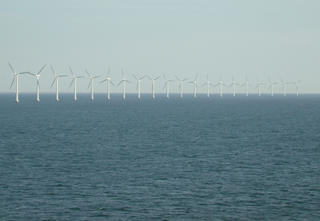
Madame Matisse
Helen Frankenthaler, 1983
Acrylic on canvas, 60x122 1/2 inches
University Art Museum
State University of New York at Albany
Born in 1928 in New York City.
"Frankenthaler is best known for changing the direction of Abstract Expressionism in the 1950s when she began pouring cans of paint directly onto unsized, unstretched canvas. Madame Matisse is an example of how acrylic paint improved Frankenthaler's technique. The water-based paint helped intensify color stains and control the halo effect that oil paint produced." (From website of SUNY Albany, Art Museum
Link)
Although I do not really care for much of Frankenthaler's work, I do like this piece very much. (I judge all art work in the same way -- by the feeling it evokes in me.)
 Windmills offshore in Copenhagen. Wind power now accounts for one-half of all public power in Denmark. The Danes have reduced their reliance on oil.
Windmills offshore in Copenhagen. Wind power now accounts for one-half of all public power in Denmark. The Danes have reduced their reliance on oil. The windmills are huge, about 250 feet high.
The windmills are huge, about 250 feet high.  Windmills in Amsterdam.
Windmills in Amsterdam. And now we see that windmills have been constructed in the Philippines. As oil becomes more scarce, and the price increases, greater reliance on wind to generate electric power seems inevitable.(Link)
And now we see that windmills have been constructed in the Philippines. As oil becomes more scarce, and the price increases, greater reliance on wind to generate electric power seems inevitable.(Link)

